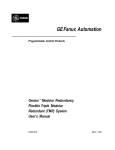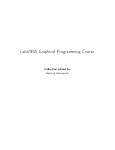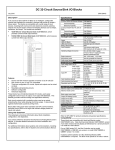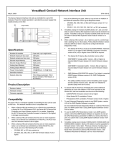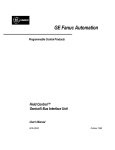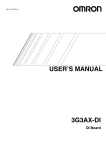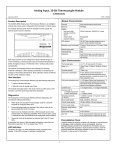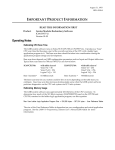Download (GMR) Phase IV Software v2.00 Information, GFK
Transcript
Important Product Information GFK-1287F February 2006 READ THIS INFORMATION FIRST Product: Genius Modular Redundancy Phase IV Software v2.00 IC641SWP745B – Compact Disk GMR System Software Release 4.04 GMR Configuration Utility Release 8.06 General Description This is an upgraded version of Genius Modular Redundancy (GMR) software that provides Windows 2000 support for the Configuration Utility. It also addresses several issues with the Configuration Utility and System Software. This version replaces version 8.05a of the Configuration Utility, and 4.02c System software provided in IC641SWP745A. Software upgrades may be purchased from a distributor. This version of Genius Modular Redundancy (GMR) software has the features and functionality described in the GMR User’s Manual, GFK-1277D. A copy of the manual is provided on the CD with the Configuration Utility. Compatibility Logicmaster and CPU This release requires Logicmaster 90-70 release 6.02 or later. This new software is only compatible with the IC697CPM790 CPU, release 6.02 or later. Firmware release 6.03 or later is required to enable the Ethernet interface for programming This new software is NOT compatible with the IC697CPU788 or IC697CPU789. Series 90-70 Genius Bus Controller Release 5.4 or later Genius Bus Controller (IC697BEM731) firmware is required. Genius Hand-Held Monitor Hand-Held Monitor IC660HHM501H version 4.5 or later is required. Genius Blocks Version 4.02 GMR software supports the following Genius blocks in GMR groups: ▪ ▪ All Genius analog input blocks. The following discrete Genius block versions are compatible with version 4.02 GMR software: IC660BBD020U, IC660BBD021U, IC660BBD024V, IC660BBD025U Other types of Genius blocks can be used as non-redundant blocks in the same system. Field Control Products The following Field Control devices are supported: ▪ ▪ ▪ ▪ Field Control Bus Interface Unit, version IC670GBI002E. 8-Channel Current Source Analog Input module, version IC670ALG230A. RTD module, IC670ALG620. Thermocouple module, IC670ALG630. Important Product Information: GMR Phase IV Software GFK-1287F February 2006 ▪ 16–Channel Current Source Analog Input module, IC670ALG240. VersaMax Products The following VersaMax devices are supported: ▪ ▪ ▪ ▪ Any Versa Max Power Supply Network Interface Unit IC200GBI001 Any 4-Channel Analog Input Module Any 8-Channel Analog Input Module These Field Control and VersaMax modules may be used as voted input devices; however, they are not included in the list of TUV approved devices. Incompatible Devices GMR is incompatible with the Series 90-70 GDS module. The Series 90-70 GMR CPU 790 release 6.02 is incompatible with CIMPLICITY 70. Problems Resolved by This Release This release of GMR addresses the following issues of previous release of GMR (4.02c System Software and 8.05a Configuration Utility). System Software v4.04 ▪ Error code 11501 is correctly reported if a certain section of GMR code is improperly accessed. ▪ A diagnostic reset occurs on the rising edge of a DIAGRES. This behavior, which triggers a diagnostic reset on the rising edge of a DIAGRES in any PLC, is consistent with the other GMR to USER functions. ▪ Starting PLCs simultaneously does not cause a nuisance “Program Changed” to be logged by one of the PLCs. ▪ Changing ALG block fault reporting for analog block BBA026 does not cause GMR Fault Handler message 10899. ▪ Changing the configuration of ALG block fault reporting does not unexpectedly cause an INVALID CONFIG error message. ▪ If there is no I/O present in a duplex or triplex system, the PLC identity is not assumed to be PLCA. ▪ A system that has communications between PLCs without I/O groups will not have erroneous Loss of Device 0 faults. ▪ ▪ If a %M discrepancy exists, the third PLC will synchronize correctly. ▪ ▪ Non-discrepant analog inputs are voted correctly in Duplex mode. ▪ Loading a Simplex configuration into PLCB or PLCC or loading a duplex configuration into PLCC will correctly generate a mismatch error message. PLCB and PLC C can be started when PLCA is autotesting the last output group without causing PLC C to report error “GMR1-ST2@10h”. If an I/O reset is initiated while there are standing faults on duplex groups, the inputs are voted correctly. Important Product Information: GMR Phase IV Software GFK-1287F February 2006 ▪ During an I/O shutdown, performing an I/O reset does not cause outputs to change state from their set defaults. ▪ During an I/O reset, premature or spurious inputs will not be incorrectly interpreted as discrepant inputs. ▪ During an autotest sweep, the output group shutdown timers are triggered consistently. Configuration Software v8.06 ▪ Inserting redundant output groups and changing busses in the configuration does not cause an overlap in the groups, resulting in an invalid configuration. ▪ ▪ The “About Form” reads the owner/organization for Windows NT systems correctly. ▪ ▪ ▪ The printer settings will be remembered during a current configuration session. ▪ ▪ ▪ The Rack/Memory/Error dialogs inactivate the GMR I/O Groups section of the toolbar. VersaMax and Field Control non-voted inputs are not labeled as “voted” on printouts of the system configuration. The configuration utility limits the insertion of GBC groups to 31 GBCs. The configuration utility will not try to reuse Serial Bus Addresses that have already been used. The %M Sync data cannot be configured to overlap the reserved %M system status data area. The maximum watchdog timer setting of 2250ms is correctly reported if a higher setting is attempted. Restrictions and Open Problems All standing faults should be corrected prior to issuing an I/O reset: If an input point has a standing fault when an I/O reset is initiated, the GMR software clears that fault and includes the input value from that module in the voting until the Genius device re-reports the fault. This can cause the voted input to be set to an unrealistic value during the time between the I/O reset and the time the fault is received. Be sure that all faults are corrected prior to issuing an I/O reset, or design the application logic to hold the outputs in their current state long enough to allow all standing faults to be re-reported after an I/O reset. Configuration of VersaMax modules in GMR systems: There are certain failures of VersaMax modules that the GMR software does not recognize. If such a failure does occur, instead of discarding the associated inputs and adapting the voting, the GMR software includes the values from the faulted Genius NIU in the voting. The result can be that the voted input value becomes set to the GNIU’s default input value. Therefore, the GNIU’s default input values must be configured for their safe states. When VersaMax modules are included in a GMR system, configure the system according to the following rules: 1. Using the NIU Configuration Tool within Machine Edition, configure each Genius NIU as follows: a. On the “Module Parameters” tab of every input module, the "Default / Hold Last State" parameter must be set to "Default", and the “Report Faults” parameter must be set to “Enabled.” b. On the “Input Parameters” tab of every input module, the default input value for every input channel must be set to its safe state. The value chosen here should match the default value chosen for this channel in the GMR configuration (see item #2b). Important Product Information: GMR Phase IV Software GFK-1287F February 2006 c. On the “Network” tab of the GBI001, the "Report Faults" parameter must be set to "Enabled", and if the NIU is part of a duplex or triplex input group, the "CPU Redundancy" parameter must be set to "Hot Standby". 2. Using the GMR Configuration Utility, configure each voted VersaMax input channel as follows: a. The Engineering Units Max and Min values must represent the full range of input values that the module can report to the PLC. b. The Default State must be set to the safe state. Use and configuration of Field Control Modules in GMR systems: There are certain failures of Field Control modules that the GMR software does not recognize. If such a failure does occur, instead of discarding the associated inputs and adapting the voting, the GMR software will include the values from the faulted Genius Bus Interface Unit (BIU) in the voting. The net result can be that the voted input value becomes set to the BIU’s default value, which can only be configured for 0 or Hold Last State. Therefore, the use of Field Control modules in a GMR system must be limited to cases where 0 is the safe state for the associated input channels. When Field Control modules are included in a GMR system, configure the system according to the following rules: 1. Using a Genius Hand-held monitor, configure each Field Control Genius BIU as follows: a. For each module attached to the BIU, fault reporting should be enabled for every channel that is used, and the "Hld Lst State" parameter should be set to “NO”. b. The BIU’s “Report Faults” parameter must be set to “YES”. c. If the BIU is part of a duplex or triplex input group, its “CPU Redundancy” parameter must be set to “Hot Stdby Mode”. 2. Using the GMR Configuration Utility, configure each voted Field Control input channel as follows: a. The Engineering Units Max and Min values must represent the full range of input values that the module can report to the PLC. b. The Default State must be set to the safe state, which should correspond to the value 0. Special Operating Notes 1. Misconfiguring the Number of PLCs in the Series 90™-70 GMR System may result in Unreported Output Discrepancy Faults: The GMR Configuration Utility is used to select the operational and hardware parameters for a GMR system. Should the user fail to configure the GMR system with the actual number of PLCs, the GMR software could fail to report some Output Discrepancy faults. For example, a Triplex system configured with only two PLCs could result in a failure to report some discrepant outputs from the third PLC. Likewise, a Duplex system configured with only one PLC could result in a failure to report some discrepant outputs from the second PLC. This misconfiguration will not be indicated with a system fault message, and the GMR PLCs will appear to operate normally. To assure that there is no such misconfiguration, GE Fanuc advises the use of appropriate verification procedures, as well as careful configuration practices as identified in the Genius® Modular Redundancy User’s Manual – GFK-1277. Important Product Information: GMR Phase IV Software GFK-1287F February 2006 Specific verification procedures include: ▪ Ensuring that the current GMR Configuration printout indicates the actual number of active PLCs. ▪ Using the Logicmaster™ 90 Programming package to toggle the %M12262 – “REPORT” control reference so that the system will report the current GMR checksum in the PLC Fault table. ▪ Verifying this checksum with the one listed in the GMR Configuration printout. Any inconsistencies indicate improper GMR Configuration settings that should be corrected at the earliest opportunity. 2. Normal State Must be Configured Appropriately for Critical Outputs in Fire and Gas Application: Critical outputs in a Fire and Gas application must be configured such that the ‘normal’ state is the opposite of the safe or demand state as appropriate, so that the GMR diagnostics will perform correctly. For example, normally energized (‘on’) outputs will be forced to the safe, or de-energized state, in the event of failure, whereas normally deenergized (‘off’) outputs will be forced to the energized state (as in a Fire and Gas application). To configure outputs in this manner, bring up the GMR Configuration Utility and select the output group as shown. Select (mouse click) the Normal State tab for the associated output group, to display the following screen. The normal state can be configured on a point by point basis or, with the Select All and Clear All buttons, can be configured uniformly for all points in that output group. Important Product Information: GMR Phase IV Software GFK-1287F February 2006 3. Output Autotest Faults When Outputs are Rapidly Changing State: In addition to the output discrepancy faults that can occur as a result of non-steady-state outputs in redundant output groups, it is also possible that Output Autotest faults could occur. This may happen under very narrow timing conditions when the output block’s state has been overridden to the de-energized state (during the Autotest sequence) and the output value changes. This would cause the Autotest to fail, resulting in a Output Autotest fault message. A second side effect is that the output would remain overridden in the de-energized safe state, consistent with TUV requirements. Note that this TUV requirement applies only to outputs which are normally energized, as determined by the setting in the GMR Configuration Utility. Those outputs configured as normally de-energized will not see this particular fault under these conditions. Because of the asynchronous operation of CPUs in a GMR system, it is possible that output blocks, while voting the output from three separate CPUs, could “see” a discrepancy when an output is simply changing states. Earlier versions of GMR dealt with this situation by filtering discrepancies that occurred during state changes. However, under some circumstances, this default filter may be inadequate. A field has been added to the GMR Configuration Utility (revision 7.00 and later) that allows the user to adjust the filter by adding a configurable number of seconds (between 0 and 65535). In effect, an output discrepancy would have to exist for the configured number of seconds before being reported as a fault. (For more information on GMR Output Discrepancy reporting, see the GMR User’s Manual.) To access the parameter in the GMR Configuration Utility, select ‘View’ from the menu bar, followed by ‘System Configuration…’ Then select the Options tab to reveal a screen similar to the one below: In the Discrepancy Filter area, a value can be entered for Output. A value of ‘0’ will cause the system to act just as earlier versions of the GMR Software now operate, with the filtering algorithm described in the User’s Manual. This is the default value. Important Product Information: GMR Phase IV Software GFK-1287F February 2006 4. Fault Table Contents When a GMR CPU is in Stop Mode: If a GMR CPU has been in Run mode and on-line, then subsequently is put in Stop mode, some faults may be reported incorrectly or may not be reported at all. When the CPU is returned to Run mode the fault table resumes normal operation. Each time a CPU is put into Run mode and on-line, an I/O fault table reset should be performed by using the GMR “IORES” control bit (%M12258) as described in the GMR User’s Manual GFK-1277C. This operation will ensure that the I/O fault table is updated with the current and correct fault information. 5. An I/O Shutdown Canceled Message is logged in the PLC Fault Table following a Supervised Output Shutdown: If a fault condition exists for an output group that results in a supervised output shutdown, the shutdown occurs as it should, but then an erroneous Shutdown canceled message is erroneously entered in the fault table 6. Slow response to IORES and FRCLOG after power cycle is to be expected. Following a power cycle of multiple CPUs, the actions performed by GMR control bits “IORES” (%M12258) and “FRCLOG” (%M12263) can take several minutes to complete. The GMR status bit “IORESIP” (%M12238) can be monitored to transition to the off state to verify that the “IORES” request completed. Subsequent use of these control bits result in normal response times 7. Field Control BIUs and Versa Max NIUs must be configured in Hot Standby mode for proper fault contact behavior. Otherwise, fault contacts may not be consistent in all CPUs. Hot Standby mode should be used for all input blocks and modules when GMR mode is not an available selection. Also, the appropriate CPU firmware (6.02) must be used with this release in order for fault contacts to be cleared properly following an IORESET. (Note: The Versa Max NIU Configuration Utility must be used in order to place Versa Max NIU in Hot Standby mode. For more information, contact GE Fanuc Technical Support at 1 800 GE FANUC ) 8. CPU Memory areas should be cleared as a standard procedure step, when storing application code and re-starting the system. Otherwise, the redundant PLCs may not synchronize correctly.







